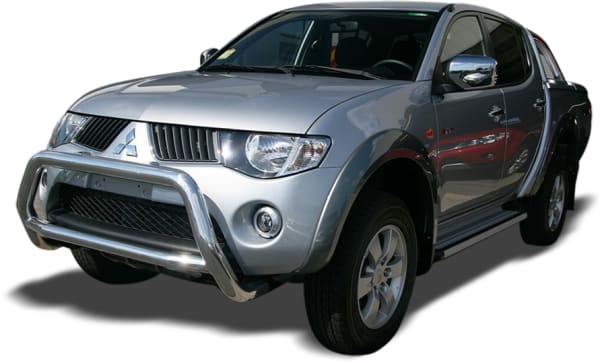
Mitsubishi Triton and Outlander 2009 Review
- Mitsubishi Outlander
- Mitsubishi Triton
- Mitsubishi Outlander 2009
- Mitsubishi Triton 2009
- Mitsubishi Outlander Reviews
- Mitsubishi Triton Reviews
- Mitsubishi Reviews
- Mitsubishi Commercial Range
- Mitsubishi Ute Range
- Mitsubishi SUV Range
- Commercial
- Ute
- SUV
- Mitsubishi
- Family Cars
- Tradies
There’s a tinge of green punctuating the hard red colour of South Australia's Eyre Peninsula landscape for the launch of the Mitsubishi Triton and Outlander. But still more than enough red to promise a decent dust-gauntlet for seals and filters.
On descent into Mt Ive Station, there's a line-up of pre-production machinery from Mitsubishi ready to test seals, tyre durability and underbody protection.
The dirt strip at Mt Ive Station looks rougher than a shearer's chin but after a remarkably smooth touchdown we're wandering across the strip towards the new Outlander compact SUV and its Triton stablemate.
One looks decidedly out of place, the other comfortable among the sheds, huts and homesteads of Mt Ive - but the new-look Outlander has more grit than first impressions suggest.
The initial drive out of the homestead showed that despite decent rains there was still plenty of dust. And both models dealt with the journey over rough farm tracks and half-decent faster dirt roads in a reasonable manner.
Drivetrain
The new-look Triton is not a massive departure from the outgoing model and the six-speed manual turbodiesel 4WD GLX-R is quickly firming as the pick of the crop.
The top-spec model is propelled by a new 2.5-litre variable-geometry turbodiesel that offers 131kW and 400Nm, which despite being 0.7 of a litre smaller than the outgoing powerplant offers 11 per cent more power, 17 per cent more torque and nine per cent better fuel economy at 8.3 litres per 100km.
Mitsubishi says that's more power than the Toyota HiLux (which just pips the Triton on fuel use), Holden's Colorado, Nissan Navara (which is the only one with more torque), the Ford Ranger and the Mazda BT-50.
The automatic models - four-speed autos on all bar the GLX-R, which gets a new five-speed - have to make do with 350Nm and claim 9.3l/100km, but the automatic drivetrain is not as sharp as the manual.
The two-wheel drive models make do with the carry-over 2.4-litre 94kW/194Nm petrol and 2.5-litre 100kW/314Nm turbodiesel four-cylinder engines.
Variants and pricing
Mitsubishi indicated that there would be no big price rises within the upgrade and the prices have remained largely unchanged.
The new Triton GLX single cab-chassis 4WD starts from $34,590 for the diesel manual, with the auto adding $2000 across the range; the GLX dual-cab 2.5 diesel manual pickup starts from $41,990.
The GL-R dual-cab 4WD starts from $44,990 and the GLX-R dual-cab 4WD is priced from $47,990.
Equipment and fit-out
The GLX-R sits on 17in wheels and on faster unsealed roads points nicely - it feels better than smaller-wheeled Triton GL-R models that we sampled on the Gawler Ranges roads. The GLX-R gets standard Super Select on-the-fly four-wheel drive system, as well as stability and traction control, with the option of a rear diff lock.
Range-wide safety gear includes dual front airbags and anti-lock brakes, with brakeforce distribution. Stability and traction control, as well as side and curtain airbags are available as options. The stability control is unobtrusive in its applications and even with the electronics off the Triton's all-wheel drive has ample traction.
Driving
The new diesel is quiet and delivers its outputs like a petrol engine. With road pressures in the tyres, a short sand dune stint showed the strong power delivery of the diesel, which maintained the Triton's progress despite thick, boggy sand.
It was prone to push the nose wide and kept the driver busy at the wheel but much of that would be negated of normal sand driving pressures had been applied.
The Tritons were also allowed onto hallowed speed-record ground - despite some water on the surface of Lake Gairdner, the salt crust was still more than hard enough to sustain a drive out to where the salt-racers would normally gather ... although our speeds were substantially less.
The Outlanders were kept out of the serious rock-hopping and deep-sand components of the drive program, but were expected to keep up with the new Triton - as well as the Pajero lead and ‘tail-end Charlie’ cars - and did so over rutted rocky tracks, giving the underbody the odd clang along the way.
The Tritons didn't escape unscathed either - the new Triton tray length now stands at 1505mm, with the tray height of 460mm, a 14 per cent increase. Rock shelfs and outcrops didn't take long to change the rear bumper's parallel alignment with the rear tailgate, the extra length of the new vehicle's rear tray contributing a little perhaps.
A tow bar might offset some of the rear rearrangement, and with increased towing capacities the Triton will get on more shopping lists.
The four-wheel drive range is up from 2500kg to 2700kg on 4WD long-bed dual-cab and 3000 kg on all other four-wheel drives - the boffins blaming the increased chassis length for the difference.
The Outlander has undergone some major rhinoplasty, with the Lancer being the donor - the rear has been filled out a little but it’s the front end that now has the aggressive wide-open family snout.
The new all-wheel drive system has Tarmac, Snow and Lock modes, offering similar choices to its sports Lancer Ralliart and Evo brethren via different means. Where the all-wheel drive system of the Lancer has hydraulics to apportion the drive, the Outlander uses electrics to limit wheelspin.
The initial recommendation was to use the snow setting on the loose gravel tracks but the wandering nose and tail prompted a test of the lock mode, which dealt better with the loose surface.
The road rubber on both models remained intact throughout the drive, despite some corporal punishment on the rocky roads, but grip suffers - tyres with more off-road bias would probably make quite a difference.
Both models showed they could take on tough terrain without cause for concern. The more aggressive looking Outlander offers more to those looking to go a little further off the beaten track and the new turbodiesel will make sure the Triton has no problems maintaining the light-commercial's strong recent sales history.
Mitsubishi Triton and Outlander
Price: from $34,590.
Engine: 2.5-litre DOHC 16-valve common-rail intercooled turbodiesel four-cylinder.
Transmission: five-speed manual or four-speed (GLX-R five-speed) automatic, four-wheel drive.
Power: 131kW @ 4000rpm.
Torque: 400Nm @ 2000rpm (auto 350Nm).
Economy: 9.3 litres/100km
Pricing guides
Range and Specs
| Vehicle | Specs | Price* | |
|---|---|---|---|
| GLX | 2.4L, ULP, 5 SP MAN | $6,380 – 9,020 | 2009 Mitsubishi Triton 2009 GLX Pricing and Specs |
| GL | 2.4L, ULP, 5 SP MAN | $7,480 – 10,560 | 2009 Mitsubishi Triton 2009 GL Pricing and Specs |
| GLX (4X4) | 3.5L, ULP, 5 SP MAN 4X4 | $6,160 – 8,690 | 2009 Mitsubishi Triton 2009 GLX (4X4) Pricing and Specs |
| VR (4X4) | 3.2L, Diesel, 4 SP AUTO | $10,230 – 13,970 | 2009 Mitsubishi Triton 2009 VR (4X4) Pricing and Specs |
$4,985
Lowest price, based on 41 car listings in the last 6 months














